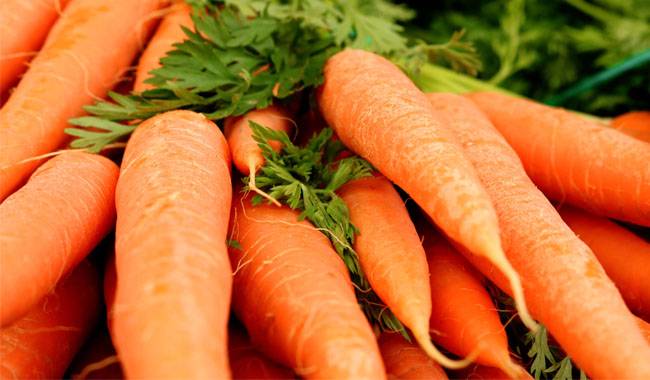
Carrots are a popular and favorite vegetable crop in every garden plot. Rich in trace elements, carotenoids, vitamins, immunity-boosting substances, which help to treat many diseases. Carrots, one of the main crops for children’s nutrition.
It is very sad if a lot of effort is spent on its cultivation and it ends up with bent, ugly, suspicious-tasting shapes because, in the case of carrots, the external and internal shapes are identical.
So, how to grow smooth, large, tasty, and highly nutritious sweet carrots? Let’s study it.
CONDITIONS FOR A GOOD SWEET CARROT HARVEST
Carrots, a frost-resistant crop which can be sown under winter, have several conditions from early spring. In southern regions, it is sown in the window of warm winter (February) and you can harvest this delicious vegetable earlier. Carrots are not afraid of frost.
To grow a decent crop, you need to be aware of it.
- Biological characteristics of carrots.
- Compliance with the requirements of cultivation techniques.
- The structure and fertility of the soil, in preparation for sowing.
- The acidity of the soil.
- The specificity of the humidity supply.
THE MAIN REASONS FOR CARROTS TO BECOME SMALL
- Carrot does not tolerate waterlogged low-lying areas, near fruits, and forest crops. She will not be smooth and elegant, more so when growing in the shade under the canopy of the garden.
- The crop needs deep, loose, nutritious, permeable, and water-permeable soil. The presence of small gravels, stones, roots, and other inclusions in the soil can cause carrot roots to bend and be crushed.
- Rootstock carrots need bright light. Arrange beds with carrots so that each plant gets enough light. Taller crops (tomatoes, eggplants) should not shade the tops of carrots. It is best to place carrots further south than their taller neighbors.
- Carrots will not flower and fruit on acidified soil. Therefore, deoxygenate the soil by applying humus, chalk, lime, and dolomite powder a year before sowing the culture in the allotment bed. The soil under carrots should be neutral and zero acidity in the pH=6-7 range.
- Inadequate soil preparation, soil deoxygenation before sowing in spring, use of fertilizers containing chlorine, excessive nitrogen fertilization, and overgrown crops will yield ugly, branched, burst carrot roots and small root crops.
- The value of carrots is determined by the amount of useful substances formed in the root crop due to metabolic processes in the presence of timely access to water and nutrients. Therefore, lack of water and nutrients at the beginning of the growing season and excess at the end of the carrot season will not only change its appearance and sign but will also significantly reduce its taste quality.
HOW DO I GET LARGE CARROTS?
Selection of carrot seeding site and predecessors
The plot should be flat, without slope, and evenly lit. Good predecessors and neighbors are zucchini and other squash, beans, onions on radishes, garlic, potatoes, tomatoes, eggplants. Celery, parsley, dill, and other umbrella plants are undesirable neighbors and predecessors. In crop rotation, carrots return to their original position in the 4th-5th year.
Preparing the soil for sowing carrots
The soil for sowing carrots is prepared in the fall. After harvesting the previous crop, the tract is removed from the plot and the autumn wave of weed growth is stirred up by water. If the area is at a disadvantage, clear stones, roots, and stems, digging on the bayonet of the spade.
Spread a mixture or compound fertilizer that does not contain chlorinated forms. The fertilizer is embedded in the soil while crushing coarse clods and leveling the surface of the plot with a rake.
Important: Do not apply deoxidizer (dolomite powder or lime) and fertilizer at the same time. The timing of these two preparation methods should be different. You can apply deoxidizer in the fall (if necessary) and fertilizer in the spring, 2-3 weeks before planting.
In spring, dig the seedbed of carrots deep again, especially if the soil is heavy clay and loamy in composition. To make it fluffy, you can make perlite or vermiculite, sand in the root layer.
Fertilizing carrots
Mineral fertilizers in the basic preparation of the soil are nitrogen and phosphorus fertilizers at the rate of 50-60 and 40-50 g/11 sq. ft. respectively, for the average fertility of the soil. You can make nitroprusside and ammoniacal phosphorus at 60-80 g/11 sq. ft. or a fertilizer vegetable mixture at the same rate. Fertilizer can be applied at the time of digging or at the time of final preparation of the plot (when raking).
On highly fertile soils, carrots made 1/2-1/3 of the above dose of fertilizer, sometimes only the introduction of ash – one cup per 11 square feet, followed by fertilization during the growing season. On poor soils, instead of increasing the basic fertilizer dose, use a fortified fertilizer during the first half of the carrot growing season.
Seeding time for carrots
Carrots are a frost-resistant crop. Sprouts can withstand temperature drops to 28°F (-2°C). Well-developed plants will not die in short-term frosts as low as -4°C. Taking advantage of these properties, some gardeners sow crops as soon as the soil warms to 37-39°F (3-4°C).
But for such early sowing, as well as for winter sowing, you need to choose an early maturing carrot variety. And receive sprouts on the 20th-30th day.
The best way to sow carrots is to heat a 4-6inch (10-15 cm) layer of soil to 46-50°F (8-10°C). New shoots appear on the 12th-15th days. If the initial period of carrot development will be spent at low temperatures, the plants will flower in the first year and the root crop will be coarse and tasteless.
The optimal temperature range is 62-75°F (17-24°C). If the temperature rises above 77°F (25°C), the metabolic processes in the carrot roots will slow down and the carrot roots will become fibrous. It is necessary to lower the soil temperature by watering and mulching and to lower the air by fine sprinkling (mist watering).
HOW CAN I IMPROVE THE PALATABILITY OF ROOT CROPS?
On properly prepared plots, the palatability of root carrots depends on the basic nutrients (and their proper proportions), micronutrients, and water provided during the growing season, as well as the standing density and variety.
Fertilization of carrots
Carrots are intolerant of over-fertilization and respond by reducing the quality of the root crop, especially in the case of excessive nitrogen fertilization. The pulp of root crops becomes tasteless. However, carrots need a good supply of potassium, which helps the accumulation of sugar in the roots and increases storage time and overall yield. For potassium fertilizers, it is best to use fertilizers that do not contain chlorine.
During warm periods, carrots should be fertilized 2-3 times and sometimes fed 4 times on poor soils.
First fertilization of carrots
After 3 weeks of carrot germination – with a solution of calimag and urea (15 g each / 2.5 Gal water). You can add 20 g of calcium superphosphate to the solution. If the soil has been adequately fertilized during fall and spring preparation, the first application can be done later, at the stage of 5-6 leaves.
Second fertilization of carrots
After 2-3 weeks, make a second application of fertilizer by introducing the same dose of Kemira’s general-purpose fertilizer (50-60 g per 11 sq. ft.), NITROFOSKA, Solubility.
Third fertilization of carrots
The following fertilization with ash (on moist soil) at a rate of 20 grams per 11 square feet or with a mixture of micronutrients was made in 2-3 weeks (during the root growth stage). The root growth stage is at the end of June-July.
For sweetness and tenderness of the fruit, a foliar solution of boric acid (2 g/2.5 Gal water) is effective for feeding for 2 to 3 months. Potassium is very important in the elemental composition and helps to deliver nutrients to root crops. Therefore, the 3rd application can be made at a rate of 30 and 40 grams of phosphoric acid per 11 square feet.
4th fertilization of carrots
On poor soils, if necessary, make the 4th application of fertilizer, which belongs to the maturity stage of the root crop. This is usually done to expand the fruit. This is usually done from early to mid-September (depending on the maturity of the variety). It is possible to use the same fertilizers and doses as the third fertilizer, or a different combination, excluding nitrogen.
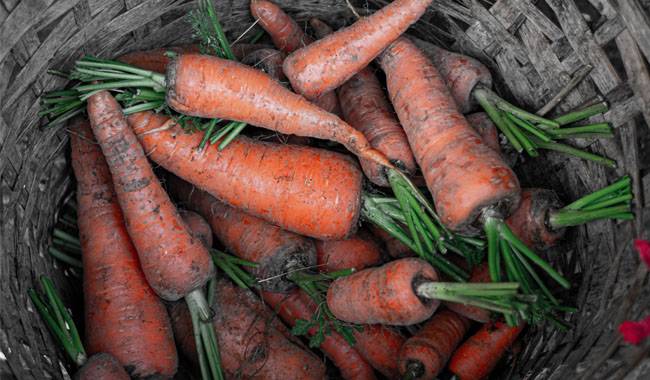
WATERING CARROTS
The small, bitter, woody fruits of carrots are obtained in the absence of water, especially between sowing and germination, and during the intensive growth phase of root crops. The topsoil should be continuously moist until germination.
Watering during this period is best done in the late afternoon with a fine mulch no higher than 0.8-1.2inch (2-3 cm) between the rows. With fluctuating moisture conditions and over-watering, carrots can form a large root crop, but they will be tasteless and full of cracks.
After germination, water the culture weekly until the root crop grows, then switch to watering 2-3 times a month, but increase the rate of watering. After each irrigation, the carrots must be mulched. It prevents the formation of crusts and reduces the temperature in the upper layers of the soil. Two weeks before harvesting, stop watering.
RULES FOR UNCLOGGING CARROTS
Neatly arranged carrot roots are grown in proper 2-3 thinning of carrots. The first thinning is done after the appearance of the 3rd leaf. Before thinning, the rows are loosely spaced and watered. Remove seedlings by pulling or tweezing, but do not pull them so as not to disturb the root system of the remaining plants.
The waste is moved away from the beds to avoid attracting carrot flies. To repel it after the reduction, you can scatter onion arrows or mulch the plants in the rows. 2.5 to 3 weeks later, repeat the thinning by increasing the distance between plants from 0.8inch (2cm) to 2.4inch (6cm).
The third thinning is actually the first harvest. Carrots require a high air regime in the soil. Every 7-10 days, the carrot rows are loosened by turning the mulch.
CARROT VARIETIES
To grow sweet carrots it is necessary to select varieties of condiments with certain root quality. Breeders offer a variety of early, medium, and late-maturing seeds with high sugar content, dessert taste, long shelf life, and other qualities. If necessary, annual catalogs of varieties and hybrids allow the selection of root crops with the desired quality.
More related information about growing carrots plants





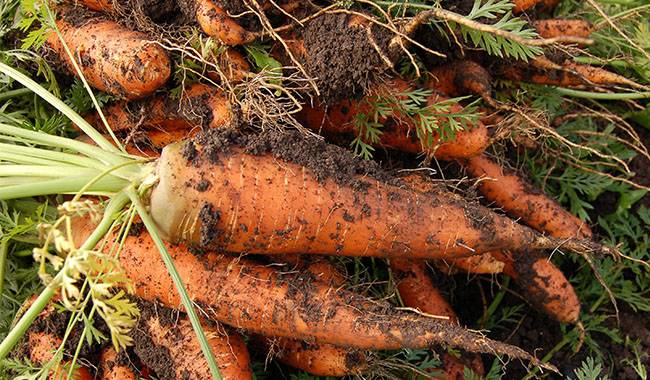
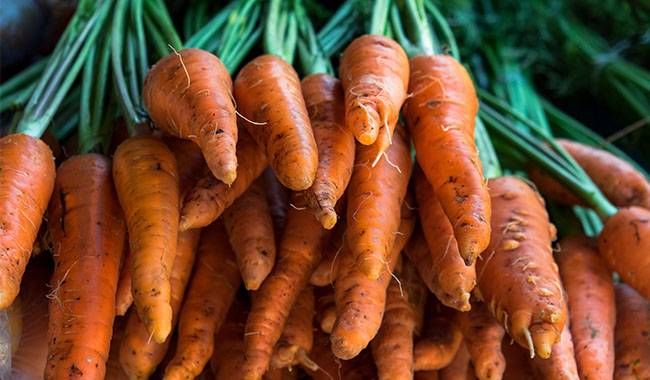
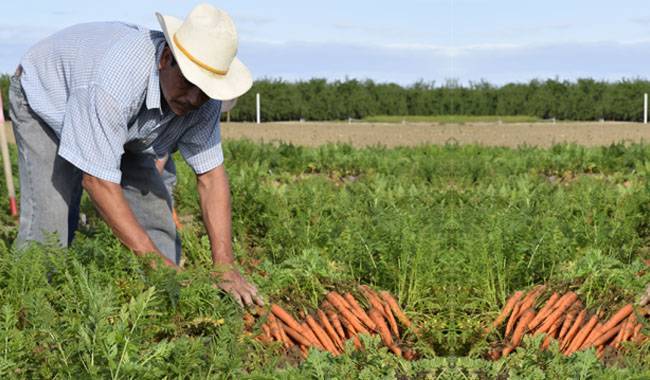
Great ARTICLE.